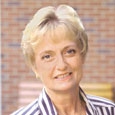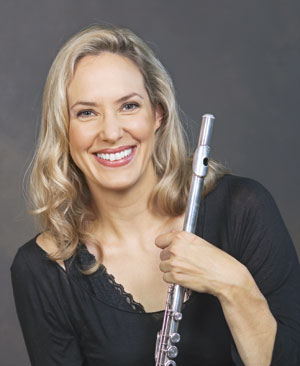 Linda Chatterton grew up in Fort Atkinson, Wisconsin, a town of about 10,000 people in the south central part of the state. “My mother played piano but not professionally, although she did have a number of private piano students. I went through the grade school band program, and we all had group lessons. It was a good band program that put me on the right foot from the beginning.”
Linda Chatterton grew up in Fort Atkinson, Wisconsin, a town of about 10,000 people in the south central part of the state. “My mother played piano but not professionally, although she did have a number of private piano students. I went through the grade school band program, and we all had group lessons. It was a good band program that put me on the right foot from the beginning.”
She was one those kids who loved to practice. “My parents didn’t have to nag me about it; I would lock myself up in my room and practice. My Dad jokes that I went into my bedroom in the 8th grade and didn’t come out again until they loaded me into the car to take me to Eastman!”
Then as now, she loved performing. She played in church and solos at school. When she reached the eighth grade, her mother thought private lessons would be a good idea so she began studying with Dr. Robert Webb, who was teaching flute at the University of Wisconsin in Whitewater.
“Dr. Webb was incredible. He always gave me recordings to listen to by such artists as Rampal, Galway, Carol Wincenc, and Paula Robison. When I started studying orchestra excerpts, he gave me recordings of the orchestra pieces. We started each lesson with harmonics – he’s written a tone book that incorporates tons of harmonic exercises, and I think his students were his test subjects. He used a lot of Moyse materials, and we always ended each lesson with a duet. He is 80 years old now and retired to Florida, but he still sounds amazing. I visited him last winter and we played Kuhlau duets.”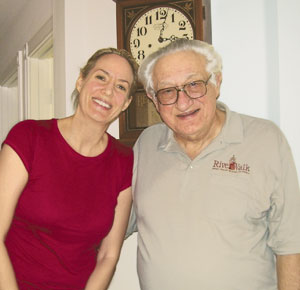
She was 13 when she decided she wanted to be a professional musician. “I remember the exact moment vividly: I was sitting at my desk in school and looking down at my flute. I had just gotten my first open-hole flute. It hit me like a bolt of lightning: ‘I could play the flute for a living!’”
During high school, youth orchestra opportunities were nonexistent in her area, so once a week Chatterton’s mother drove her to Milwaukee – a 60 mile trip – for rehearsals. She also took part in solo competitions and spent a summer at the Interlochen Arts Academy.
Her entrepreneurial tendencies began to develop at this time as well. “I really wanted to go to Interlochen during the winter too, but my parents thought it was too expensive, so I embarked on a huge letter-writing campaign to many of the business owners of Fort Atkinson to raise money for the summer program. I told them my story and asked them for financial support. It actually was quite successful, and it was a good learning experience for all the grant writing and proposal pitching that I do now as a professional.”
For college she chose the Eastman School of Music and studied flute with Bonita Boyd. “My intent was to go somewhere in the midwest for a masters degree. During my senior year I took some orchestra auditions and made the finals in a couple of them, but I just felt that I needed a bit of a breather from the area. I went to the University of Minnesota in Minneapolis, where I studied with Julia Bogorad. After I got my master’s degree, I decided to stay in Minneapolis, and I have been there ever since. There is such a love of the arts in Minneapolis – orchestras, theatre, and arts education.”
“I’ve been very blessed with having wonderful teachers. Dr. Webb gave me an excellent foundation, and Bonnie and Julia had totally different approaches, which was perfect for me as a student. Bonnie was very much of the “find your own path” philosophy in terms of sound, musicality, tone colors, and so on. She used her students’ talents and their natural abilities to guide her teaching style.
“Julia Bogorad was grounded in Moyse and orchestral playing, so she was a little more pedagogical in her approach, specifically mapping out how phrases in music are structured, what to do in order to get a dark tone color, etc. I like to think that I use a combination of all of these approaches in my own teaching.”
Teaching
Chatterton has a small studio of private students in her home. “My youngest student is in 6th grade, and my oldest is around 75. I teach a range of abilities, but most are quite advanced. I have a special place in my heart for the adult amateurs, who are such interesting, lovely people. They come to the flute because they love it. They usually have very interesting lives and jobs, and many of them have gone on to become friends.”
Although Chatterton is not associated with a college or university, she has created a varied and active career for herself. “When I was growing up, my Dad had his own business. He built custom homes, and my Mom helped run the business. I learned a lot from both of them. I think you either have an entrepreneurial bent or you don’t, and I definitely have it. Over the years I have learned that you ride the waves of success and stay true to what you are passionate about.
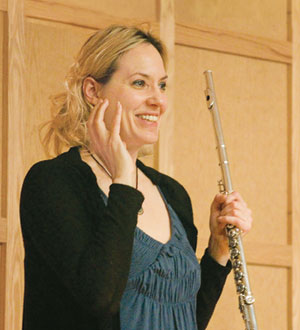 “I do concerts and masterclasses all over the country. The concerts are mostly with pianists or harpists. I’m also in a flute-cello-harp trio in Minneapolis. I just finished my fifth recording and also give performance anxiety clinics. I am actually writing a book about it at the moment. I also give guest lectures for music business classes.”
“I do concerts and masterclasses all over the country. The concerts are mostly with pianists or harpists. I’m also in a flute-cello-harp trio in Minneapolis. I just finished my fifth recording and also give performance anxiety clinics. I am actually writing a book about it at the moment. I also give guest lectures for music business classes.”
She has established this solo career without benefit of an agent. “At the heart of it, I believe that I have a special gift and a message that is of value to an audience. Practically speaking, to manage my career, I spend more time in the office than in the practice room. Nobody likes making calls pitching concert ideas, looking for work, and generating publicity. I really hate making cold calls, so I usually send out emails.”
“I contact colleges and concert series to discuss whether my programming could fit into their offerings and work with a booking agency as well. For example, I will be on tour during March with about 20 concerts that the agency has set up. I have had a relationship with the booking agency for about six years, so they know me and my playing.”
“When flutists go to school, they all think they are going to be orchestra players. We practice our excerpts and prepare for the auditions, but even in college, I was already booking solo gigs. A solo career was where my true passion was. It wasn’t so much that ego thing of being on stage, I just really love communicating with an audience. I always talk with the audience, tell them about the pieces, and spend time at intermission chatting with them as well. It’s a way to connect, and I use my flute to do that also. I think if you don’t have that passion, it is probably the reason why you are sitting at home waiting for the phone to ring.”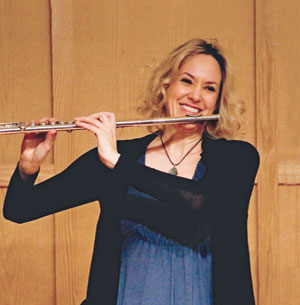
“I love performing new music and working with composers. On several concerts this fall I played the American premiere of Bruce Stark’s American Suite and also performed Gaze by John Halle for flute and piano, which was difficult but a lot of fun. I commission works and want to keep doing that. One of my favorite commissions is a solo piece called This Floating World by Edie Hill, who is a Minneapolis composer. She wrote the piece for me based on the imagery found in five haiku poems. They are five charming little vignettes that not only are beautifully written for the flute but also match the imagery of the poetry perfectly. I have played the piece for audiences around the country who really enjoy it. Brent Michael Davids, a terrific Native American composer, will be writing a concerto for me based on various Native American traditions of courting flutes.”
Yoga and Exercise
“I am a runner and do yoga. As an interesting side story, I was having some back pain, so I went to a chiropractor who took x-rays. It turns out that one whole side of my body is significantly stronger than the other, so much so that my spine is a bit crooked. One hip is even higher than the other. It never occurred to me that holding a flute could make such a difference.
“I’ve done a little Alexander Technique and David Gorman’s LearningMethods with a teacher in the Twin Cities. LearningMethods teaches you to be aware of the messages you are telling yourself and how they affect how you move your body. For example, my neck is somewhat out of alignment because I tend to move toward the flute instead of bringing the flute to me. Because I am concerned about getting my point across to the audience or to students, I have a strong inclination while playing to move my head forward, toward the audience. After two decades of flute playing, both of these tendencies have taken my neck out of alignment. Awareness is half the battle and I am working on changing the habit.”
Performance Anxiety
When Chatterton was in high school, Robert Webb gave her a copy of Psycho-Cybernetics by Maxwell Maltz. This self-help book was read by millions of people, first in the 1960s and later in the 1980s. A major part of the book is devoted to visualization. For musicians this means using an exercise for weeks before a recital in which you see yourself walk on stage, take a bow, and perform a recital easily, thereby programming the brain with positive input before actually playing the recital. Chatterton uses the book in the performance anxiety workshops that she leads.
“Even people who don’t have performance anxiety want to improve, and everybody gets a little bit nervous before they go out on stage. I have never had debilitating performance anxiety, but when I was in high school and college, I wanted to be more consistent in my performances and feel comfortable in front of the audience. I didn’t want to hold anything back because of fear that I would make a technical mistake. Visualization is a good way to do that.
“There are performers who focus on realizing the composer’s intent and being true to the music. Of course you need to be stylistically true to the composer and the time period, but when I work on a piece, I try to be aware of the thoughts and feelings that come from my own mind and experiences.
“Recently I was practicing the Copland Duo for a recording project. Because of his harmonic and melodic use and his very pure American sound, it brought up warm memories of family reunions when I was a kid. Now when I play the Copland, I don’t consciously think about those memories, but I think the audience gets a sense that I am absolutely committed to sharing my feelings about the piece. It is also a wonderful way to imbue a piece with life. When you think outside of music, you can ask what emotion does this bring up, or what image, or color, or anything. Visualization allows us to flex other creative muscles.
“Visualization takes time because the exercises are done in addition to your regular practice time. In college we were expected to practice 4 or 5 hours a day, and I can’t do that now. The times that I have practiced that long, I ended up hurting myself. You have to be more astute and creative as you get older and learn to achieve a great performance without spending more hours in the practice room. There are only so many times you can keep drilling a particular piece or etude until it becomes stale.”

